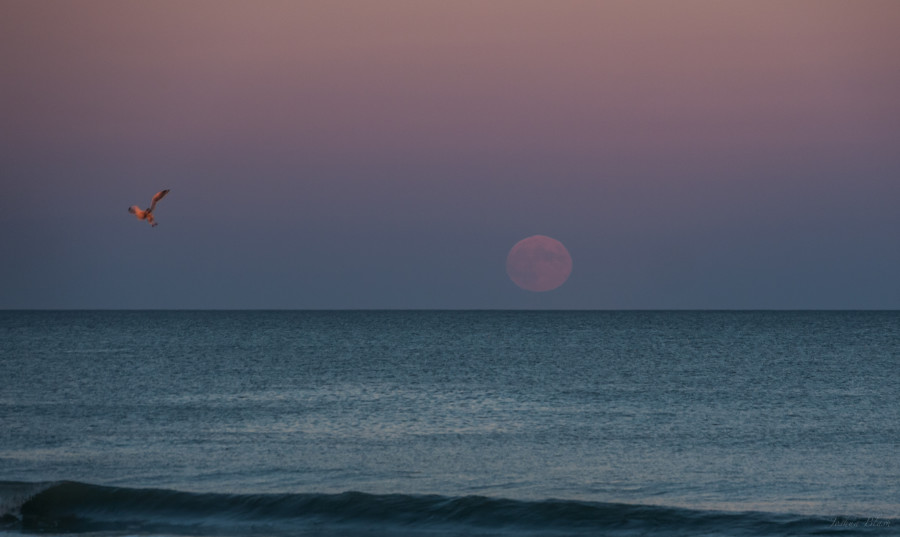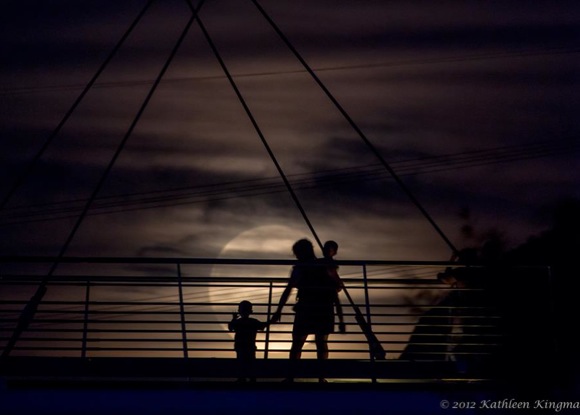Photo above: Extremely thin young moon, coming on the heels of new moon, via NASA.
We’ll have six supermoons in 2016. Depending on your time zone, the first of the bunch is to fall on March 8 or 9, 2016. Moreover, this upcoming supermoon will totally cover over the sun’s disk, to stage a total solar eclipse over Indonesia during the morning hours on March 9, and a partial solar eclipse for Hawaii and Alaska in the late afternoon on March 8. By the time you read this post, it’s possible the eclipse will be over. Its maximum point comes at 01:59 UTC on March 9, 2016 … that is, during the night of March 8 for those in the contiguous United States.
Read more: Supermoon total solar eclipse March 8-9
Likewise, the new moon supermoon occurs during the night of March 8 for those in contiguous U.S. time zones. Although we missed the eclipse, look at it this way. From North America, we might be able to catch the super-thin young moon after sunset on March 9.
What, you say? Supermoon? But the moon isn’t anywhere near full on March 9! That’s right. This isn’t a full supermoon. Rather, it’s a new supermoon. In fact, the new moons on March 9, April 7 and May 6 all qualify as supermoons. Follow the links below to learn more about the supermoons of 2016.
What time is the March 9 new moon? How close to perigee?
Spring tides accompany March 2016’s supermoon.
Can I see the March 9 supermoon?
What is the closest supermoon of 2016?
Farthest full moon of 2016 on April 22
EarthSky’s once-a-year fundraiser going on now. Please donate to help us keep going!
What is a supermoon? The term supermoon didn’t come from astronomy. We used to call these moons perigee new moons or perigee full moons. Perigee means “near Earth.” An astrologer, Richard Nolle, is credited with coining the term supermoon. He defines them as:
. . . a new or full moon which occurs with the moon at or near (within 90% of) its closest approach to Earth.
By this definition, a new moon or full moon has to come within 361,524 kilometers (224,641 miles) of our planet, as measured from the centers of the moon and Earth, in order to be a supermoon.
That’s a very generous definition, and it’s why supermoons are common in popular culture. According to Nolle’s definition, the year 2016 gives us a total of six supermoons: the new moons of March, April and May, and the full moons of October, November and December.
What time is the March 9 new moon? How close to perigee? The March 9 moon is new at 1:54 UTC. Lunar perigee – the moon’s nearest point to Earth for the month – happens about 1 day and 5 hours after new moon, on March 10, at 7:02 UTC.
The April new moon will more closely coincide with lunar perigee, to present the closest new supermoon of the year – and the second-closest overall. The April moon will be new at 11:24 UTC, and lunar perigee will occur about 6 hours afterwards, on April 7 at 17:36 UTC. The absolute closest supermoon will be the full moon of November 2016.
The May new moon will come on May 6 at 19:13 UTC, or about 15 hours after reaching lunar perigee (May 6, at 4:14 UTC).


Spring tides accompany March 2016’s supermoon. Will the tides be larger than usual at the March, April and May new moons? Yes, all new moons (and full moons) combine with the sun to create larger-than-usual tides, but perigee new moons (or perigee full moons) elevate the tides even more.
Each month, on the day of the new moon, the Earth, moon and sun are aligned, with the moon in between. This line-up creates wide-ranging tides, known as spring tides. High spring tides climb up especially high, and on the same day low tides plunge especially low.
The March 9 extra-close new moon will accentuate the spring tide, giving rise to what’s called a perigean spring tide. If you live along an ocean coastline, watch for high tides caused by the March, April and May 2016 new moons – or supermoons.
Will these high tides cause flooding? Probably not, unless a strong weather system accompanies the perigean spring tide. Still, keep an eye on the weather, because storms do have a large potential to accentuate perigean spring tides.
Learn more: Tides and the pull of the moon and sun
Can I see the March 9 supermoon? Don’t expect to see the new moon on March 9 (unless you’re at the right place on Earth to witness the March 9 solar eclipse). At the vicinity of new moon, the moon generally hides in the glare of the sun all day long, pretty much rising with the sun at sunrise and setting with the sun at sunset. On the other hand, if you were on the moon looking at Earth, you’d see a full Earth.

What is the closest supermoon of 2016? As we said above, the year 2016 will have six supermoons: the new moons of March, April and May, and the full moons of October, November and December.
The full moon on November 2016 presents the closest supermoon of the year (356,509 kilometers or 221,524 miles).
This year, in 2016, the March 9 supermoon features the first eclipse of 2016. Last year, in 2015, the September 28 supermoon presented the final eclipse of 2015 – and the fourth total lunar eclipse of a lunar tetrad – also known as a Blood Moon.
Farthest full moon of 2016 on April 22. One fortnight (approximately two weeks) after the year’s nearest new moon on April 7, it’ll be the year’s farthest and smallest full moon on April 22, 2016. People are calling this sort of moon a micro moon.
Bottom line: The first supermoon of 2016 comes when the moon turns new on March 9, 2016! No, you won’t see this moon, because the new moon hides in the glare of the sun, but you might discern the higher-than-usual tides along the ocean shorelines.












